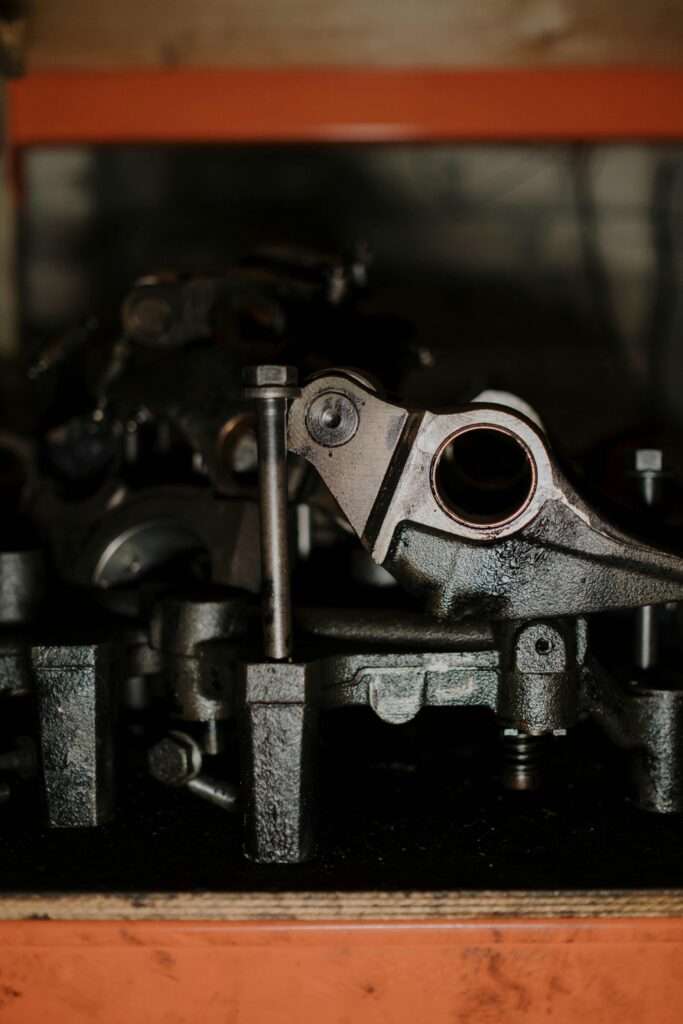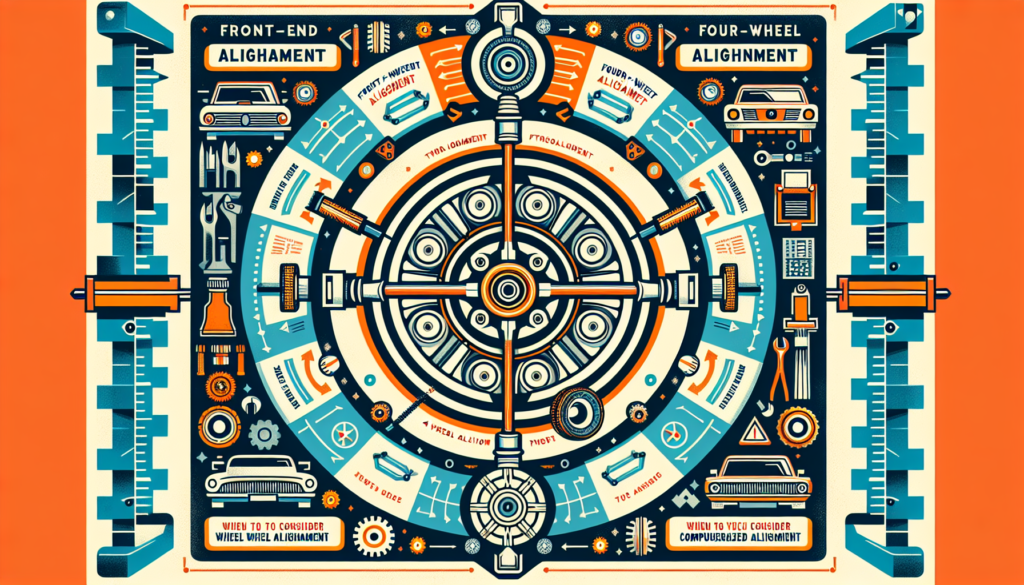Have you ever wondered about the various types of wheel alignment? Understanding these different types can help you take better care of your vehicle and ensure optimal performance on the road. Whether it’s front wheel alignment, rear wheel alignment, or all-wheel alignment, each type serves a distinct purpose in maintaining proper tire alignment and preserving the overall stability of your car. Let’s explore these different types in more detail to give you a clearer understanding of the importance of wheel alignment.

Standard Wheel Alignment
Definition
Standard wheel alignment, also known as front-end alignment, is a process that ensures the wheels of your vehicle are aligned parallel to each other and perpendicular to the ground. It involves adjusting the angles of the wheels, including camber, caster, and toe, to optimize vehicle performance and tire wear.
Procedure
During a standard wheel alignment, a trained technician will use specialized equipment to measure the angles of each wheel. This is done by attaching sensors to the wheel hubs and using laser or infrared technology to accurately measure the camber, caster, and toe angles. The technician will then make the necessary adjustments to bring the wheels back into proper alignment.
Benefits
Proper wheel alignment offers several benefits. Firstly, it improves vehicle handling and stability, providing you with a smoother and more comfortable ride. It also enhances tire life by ensuring even tire wear, which can save you money in the long run. Additionally, proper alignment can improve fuel efficiency, as misaligned wheels can cause increased rolling resistance and decrease gas mileage. Overall, a standard wheel alignment is essential for the overall performance and safety of your vehicle.
Front-End Alignment
Definition
Front-end alignment, also known as two-wheel alignment, specifically focuses on the front wheels of your vehicle. It involves aligning the front wheels parallel to each other and perpendicular to the ground, ensuring proper handling and tire wear.
Procedure
During a front-end alignment, the technician will measure and adjust the camber, caster, and toe angles of the front wheels. This is typically done using the same specialized equipment as a standard wheel alignment. By correctly aligning the front wheels, the vehicle’s steering and handling capabilities are optimized.
Importance
Front-end alignment is particularly important for vehicles with independent front suspension, as misaligned front wheels can lead to steering issues and uneven tire wear. By ensuring proper alignment of the front wheels, you can maintain optimal steering response and extend the lifespan of your tires.
Four-Wheel Alignment
Definition
Four-wheel alignment, also known as all-wheel alignment, involves aligning all four wheels of your vehicle. It encompasses both the front and rear wheels, ensuring they are parallel to each other and perpendicular to the ground.
Procedure
During a four-wheel alignment, the technician will measure and adjust the camber, caster, and toe angles of all four wheels. This ensures that all wheels are properly aligned and working together to achieve optimal handling, tire wear, and overall performance.
Advantages
The main advantage of a four-wheel alignment is that it provides complete and balanced alignment for your vehicle. By aligning all four wheels, you can ensure even tire wear, maximize tire lifespan, and improve overall vehicle stability and handling. It is particularly beneficial for vehicles with all-wheel drive or four-wheel drive systems, as proper alignment is crucial for maintaining optimal traction and control.
Thrust Alignment
Definition
Thrust alignment, also known as thrust angle alignment, is a type of wheel alignment that primarily focuses on the rear wheels of your vehicle. It ensures that the thrust angle, which is the angle between the vehicle’s centerline and the rear axle, is straight and aligned with the front wheels.
Procedure
During a thrust alignment, the technician will measure the angles of the rear wheels and compare them to the thrust angle. If any misalignment is detected, adjustments are made to bring the rear wheels back into proper alignment.
Benefits
Thrust alignment plays a vital role in maintaining straight-line stability and preventing your vehicle from pulling to one side while driving. By aligning the rear wheels with the front wheels, thrust alignment improves overall handling, tire wear, and overall driving experience.

Computerized Wheel Alignment
Definition
Computerized wheel alignment, as the name suggests, utilizes computer technology to accurately measure and adjust the wheel angles of your vehicle. It is a more advanced and precise method of wheel alignment compared to traditional methods.
Procedure
During computerized wheel alignment, sensors are attached to the wheel hubs, just like in standard wheel alignment. These sensors then collect data on the angles of the wheels, which are transmitted to a computer system. The computer analyzes this data and provides precise measurements for the technician to make the necessary adjustments.
Accuracy
The use of computer technology in wheel alignment ensures a higher level of accuracy compared to manual methods. It eliminates human error and provides real-time, precise measurements. Computerized wheel alignment allows for more precise adjustments and ensures optimal alignment of the wheels for better performance, handling, and tire wear.
Hunter Wheel Alignment
Definition
Hunter wheel alignment is a type of wheel alignment that utilizes cutting-edge technology developed by Hunter Engineering. It is known for its high level of precision and accuracy in measuring and adjusting wheel angles.
Procedure
During a Hunter wheel alignment, specialized equipment developed by Hunter Engineering is used. This includes advanced sensors and digital imaging technology to capture precise measurements of the wheel angles. The data is then analyzed by the computer system, and the technician can make the necessary adjustments to bring the wheels back into proper alignment.
Technology
Hunter wheel alignment is highly regarded for its advanced technology, such as the use of digital cameras that capture real-time images of the wheel angles. The equipment developed by Hunter Engineering allows for quick and accurate measurements, resulting in precise alignment adjustments. This technology ensures superior wheel alignment and optimal vehicle performance.

Front-Wheel Alignment
Definition
Front-wheel alignment, also known as toe-and-go alignment, is a type of wheel alignment that primarily focuses on the front wheels of your vehicle. It involves adjusting the toe angle, which is the angle at which the front wheels turn in or out when viewed from above.
Procedure
During a front-wheel alignment, the technician will measure the toe angle of the front wheels and make the necessary adjustments. This is typically done using a combination of specialized equipment and visual inspection to ensure proper alignment.
Advantages
Front-wheel alignment is essential for ensuring straight-line stability and accurate steering response. By aligning the front wheels, you can prevent tire wear, improve fuel efficiency, and enhance overall vehicle handling and safety.
Rear-Wheel Alignment
Definition
Rear-wheel alignment is a type of wheel alignment that specifically focuses on the rear wheels of your vehicle. It ensures that the rear wheels are parallel to each other and perpendicular to the ground.
Procedure
During a rear-wheel alignment, the technician will measure the angles of the rear wheels and make any necessary adjustments to bring them back into proper alignment. This is typically done using specialized equipment and visual inspection.
Benefits
Proper rear-wheel alignment is crucial for maintaining vehicle stability and preventing uneven tire wear. It ensures that the rear wheels are working in harmony with the front wheels, resulting in optimal handling and a smooth ride.

Four-Wheel Thrust Alignment
Definition
Four-wheel thrust alignment combines the principles of four-wheel alignment and thrust alignment. It ensures that all four wheels are properly aligned and that the thrust angle is straight and aligned with the front wheels.
Procedure
During a four-wheel thrust alignment, the technician will measure and adjust the angles of all four wheels, taking into account the thrust angle. This ensures that the wheels are parallel to each other and perpendicular to the ground, and that the thrust angle is straight.
Importance
Four-wheel thrust alignment is particularly important for vehicles with independent rear suspension, as misaligned rear wheels can lead to steering issues and uneven tire wear. By aligning all four wheels and ensuring the thrust angle is correct, this type of alignment promotes optimal vehicle performance, stability, and tire longevity.
Two-Wheel Alignment
Definition
Two-wheel alignment, also known as front-wheel alignment, specifically focuses on aligning the front wheels of your vehicle. It is a more basic form of wheel alignment compared to four-wheel or thrust alignment.
Procedure
During a two-wheel alignment, the technician will measure and adjust the angles of the front wheels to ensure they are parallel to each other and perpendicular to the ground. This is typically done using specialized equipment and visual inspection.
Advantages
Two-wheel alignment is beneficial for vehicles with rear-wheel drive or older vehicles that do not require alignment adjustments for the rear wheels. By aligning the front wheels, tire wear is reduced, handling is improved, and overall vehicle stability is enhanced.
In conclusion, wheel alignment is a critical aspect of maintaining the performance, safety, and lifespan of your vehicle. Whether you opt for standard, front-end, four-wheel, thrust, computerized, Hunter, front-wheel, rear-wheel, four-wheel thrust, or two-wheel alignment, each type plays a crucial role in ensuring the proper alignment of your vehicle’s wheels. By regularly getting your wheels aligned by a trained technician, you can enjoy a smoother ride, improved handling, enhanced tire wear, and better fuel efficiency. It’s a valuable investment that keeps your vehicle performing at its best.


